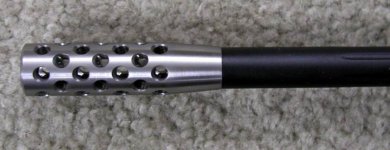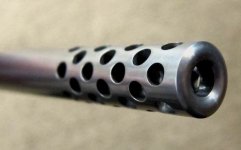This will help you understand how a brake works by looking at it...
Think of the baffle (wall at the end of each cell) like a sail on a ship. The larger the surface area, the more the gases can push the brake/rifle forward... reduces recoil
The more 'sails' you have, the more the gases can push on the rifle forward ie 5 sails are better then 4, better then 3, better then 2, then 1 (assuming you have enough gas to work the sail). With a magnum, I think the most 'sails' I have seen was 6.. with 5 being quite a long brake already. If using a smaller case, less sails as there is no benefit once you run out of gases.
The larger the area of the ports viewed from the side, the larger the volume of gases can escape sideways... as little going out the front is good. Yes, ports getting larger in area going forward should be a great idea... but I really don't know how much better in the real world.
ports should NOT point forward if you want max recoil reduction. 90deg port has little to no gases back at you and is the baseline to compare. The more the ports are inclined backwards, the higher the recoil reduction due to the 'jet' effect but the higher the possible concussion and gases into your face (no go for me).
The brake with the highest level of recoil reduction will be the largest physically, lots of sails (or cells) and for me, vent 90deg to boreline (they are sometime called TANKER brakes). I have found the calibre bore to not change recoil affect much if any BECAUSE, I use brakes that vent pretty much all the gases sideways. I use the 30cal for all rifles from 22cal on up. I much prefer knowing that there is plenty of space around the bullet so a brake strike is close to nil.
By using variations on the features above, brakes can have similar recoil reductions but look quite different... compromises include size/weight, gases to your face, length
There are some great brake comparison videos on youtube where shooters use a moving cart to demonstrate reduction
Jerry









































































